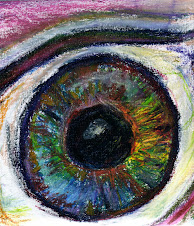Tuesday, June 30, 2009
Does Your Child Stand With One Leg or Arm Wrapped Around the Other?
Many of the children whom I see for in-office vision therapy have more than one learning-related visual issue that makes it difficult for them to succeed in school. Sometimes a child presents with a severe laterality and directionality delay. Laterality is the ability to tell left and right accurately on yourself. Directionality is the ability to project the knowledge about left and right away from yourself into space. Both are visual spatial skills, i.e. processing skills or visual perceptual skills. We discover the extent of a child's delays using a combination of tests: the Piaget Test of Left/Right Awareness, either the Jordan or the Gardner test of letter reversals, and a dyslexia screener. Children who cannot cross the mid-line or who make frequent reversals when reading or writing letters and numbers often score poorly on these tests, all of which have age/grade level expected normed scores. Then we use a series of activities in therapy to address any laterality and directionality delays. (The Yellow Book in the Eye Can Too! Read series provides parents and teachers with similar activities and information about how to understand a child's behavior when doing them.) I have recently noticed that many of the children with the most severely delayed laterality and directionality skills stand or sit with one leg wrapped around the other. They often twist their bodies when standing, and seem to be holding themselves together with the right hand grabbing their left side and the left hand grabbing their right side. I think that this postural habit exacerbates the problem by making it difficult for the child to know which body parts belong to the right side and which to the left. I have begun to coach parents to discourage their children from using these positions as another way to address the child's visual spatial problems which they sometimes express as being "confusing." I'd love to know whether others see the same correlations. Feel free to add your comments. Thanks.
Friday, June 5, 2009
Eye Hand Coordination as Demonstrated by Kindergarten Students 100 Years Ago
 These are three scans taken from kindergarten albums from my family members. The first is carefully woven paper. It was made by Mary Edwards at Froebel Kindergarten in St. Louis City in the 1907-1908 school year. The other two scans were done by a boy, Albert Edwards, who attended kindergarten in the 1899-1900 school year, also in a St. Louis public school. The portrait of George Washington is a printed picture over which Albert has sewn very tiny neat straight stitches - the blue is a coarse thread and the white is a very fine thread. The holes are different sizes denoting that the needles were too. The third scan shows a series of folded origami.
These are three scans taken from kindergarten albums from my family members. The first is carefully woven paper. It was made by Mary Edwards at Froebel Kindergarten in St. Louis City in the 1907-1908 school year. The other two scans were done by a boy, Albert Edwards, who attended kindergarten in the 1899-1900 school year, also in a St. Louis public school. The portrait of George Washington is a printed picture over which Albert has sewn very tiny neat straight stitches - the blue is a coarse thread and the white is a very fine thread. The holes are different sizes denoting that the needles were too. The third scan shows a series of folded origami.

Why did I include these scans in the Eye Can Too! Read blog? I wanted to make a statement about what kinds of activities were done at the reading readiness, preschool level in the eras before television, plastic playgrounds, and Game Boys. The eye-hand coordination required to do any of these crafts is far more mature than we expect from fifth graders today, let alone from five year olds. Not only did these children have to demonstrate very fine motor control, this kind of close work would have strengthened their eye movements so that they could gain experience converging on near point images long before they were expected to use those eye movements to decode the meaning of text.
Subscribe to:
Comments (Atom)




